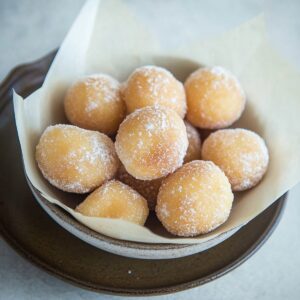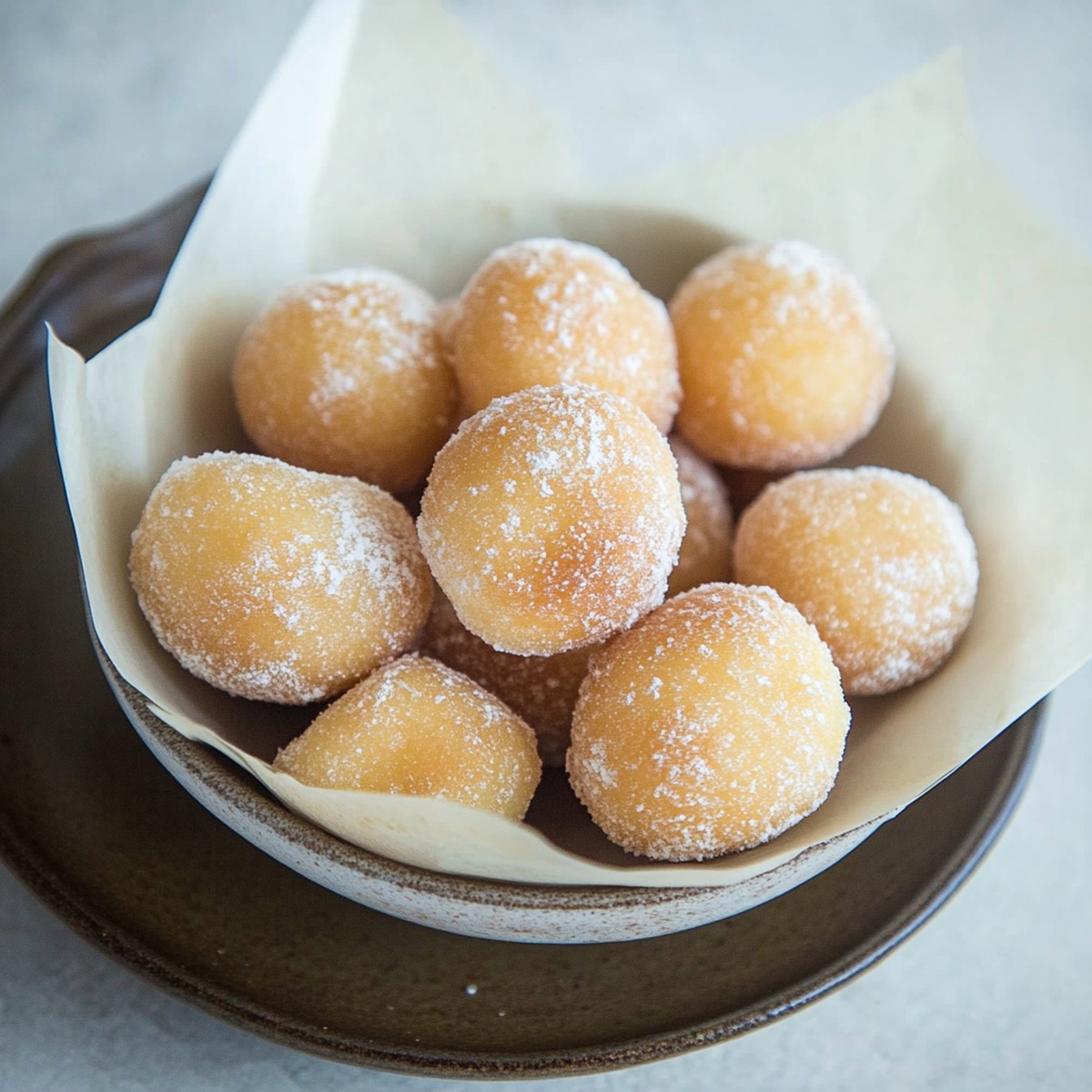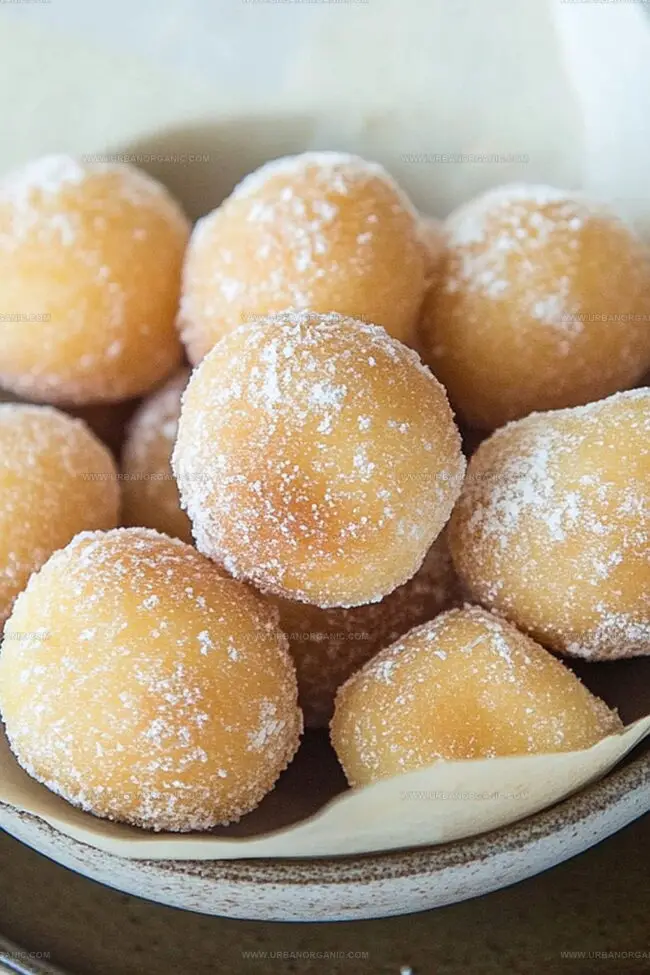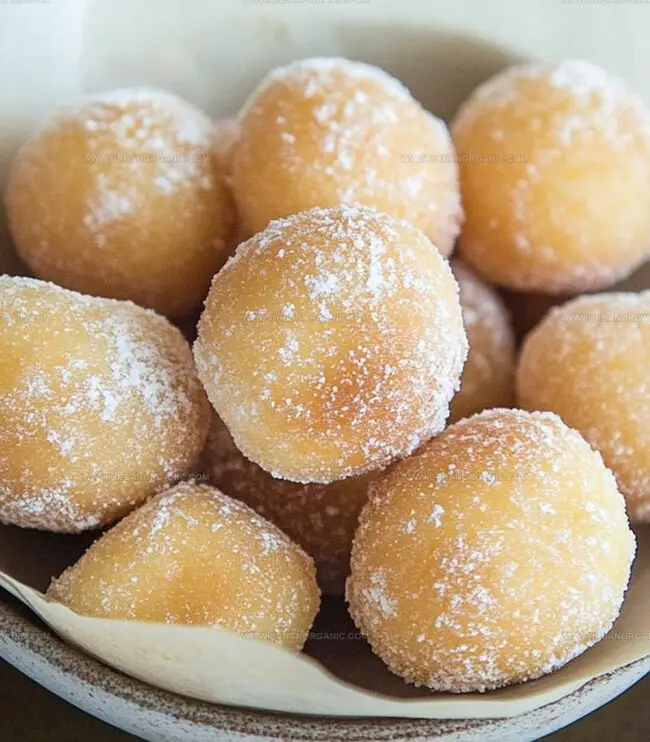Fluffiest Portuguese Doughnuts (Malasadas) Recipe Ever
Sweet dreams come alive with these authentic portuguese doughnuts that burst with cloud-like softness and golden crispiness.
Grandmothers across Portugal have perfected this delectable treat for generations.
Pillowy rounds of fried dough melt in your mouth with delightful sugary warmth.
Each bite carries rich cultural memories from the stunning islands of the Azores.
Sugar-dusted and impossibly light, these malasadas promise pure comfort in every single morsel.
Warm dough and powdered sugar create an irresistible combination that beckons you closer.
Don’t resist the temptation—these portuguese doughnuts are waiting to sweep you into a world of delicious tradition.
Malasadas with Soft Centers and Sugary Shells
What Goes Into Making These Portuguese Treats
Base Ingredients:Liquid and Binding Ingredients:Cooking and Finishing Ingredients:How to Fry Malasadas That Stay Fluffy
Step 1: Wake Up the Yeast
Mix warm water and yeast in a small bowl. Let the mixture sit and become frothy for 5-10 minutes.
Step 2: Create Dry Ingredient Blend
In a large mixing bowl, whisk together:Step 3: Combine Wet Ingredients
In a separate bowl, blend:Step 4: Merge Wet and Dry Mixtures
Add the yeast mixture to wet ingredients, then gradually incorporate into flour mixture. Knead the dough for 8-10 minutes until smooth and elastic. Use a stand mixer with a dough hook if available.
Step 5: First Dough Rise
Place dough in a greased bowl, cover with a kitchen towel. Let it rise for 1½ to 2 hours until doubled in size.
Step 6: Shape the Doughnuts
Punch down the dough and divide into golf ball-sized pieces. Arrange on a lightly floured surface and cover. Allow to rise again for 30-45 minutes.
Step 7: Heat the Oil
Warm oil in a deep fryer or large pot to 350°F (175°C).
Step 8: Fry the Malasadas
Fry doughnuts in batches for 1-2 minutes per side until golden brown.
Step 9: Drain and Coat
Remove doughnuts and drain on a paper towel-lined plate. Roll warm malasadas in sugar (optionally mixed with cinnamon).
Step 10: Serve and Enjoy
Serve immediately. For extra delight, consider filling with custard or jam.
Tips for the Best Rise and Golden Finish
Keep Malasadas Fresh and Delicious Longer
Toppings and Pairings for Sweet Doughnuts
Malasada Twists Worth Trying
Portuguese Doughnut FAQs Answered
Malasadas are a traditional Portuguese pastry that originated in the Azores, a group of islands belonging to Portugal, and were later popularized in Hawaii by Portuguese immigrants.
You’ll need a deep fryer or a large, heavy-bottomed pot for frying, a thermometer to monitor oil temperature, and basic mixing bowls and utensils.
The two-stage rising process helps develop the dough’s flavor, texture, and makes the malasadas lighter and fluffier when fried.
Yes, you can knead the dough by hand on a clean surface. It will take about 10-12 minutes of consistent kneading to achieve the right smooth, elastic texture.
Print
Portuguese Doughnuts (Malasadas) Recipe
- Total Time: 30 minutes
- Yield: 12 1x
Description
Warm Portuguese doughnuts delight senses with crispy exteriors and pillowy centers, promising sweet comfort. Golden malasadas bring sugary memories of festive Azores traditions straight to your plate.
Ingredients
Main Ingredients:
- 3 large eggs
- 4 cups all-purpose flour
- ¾ cup whole milk, warmed
- 2 ¼ teaspoons (1 packet) active dry yeast
Liquid and Fat Ingredients:
- ¼ cup warm water (110°F / 43°C)
- ¼ cup unsalted butter, melted
- 4 cups vegetable oil (for frying)
- 1 teaspoon vanilla extract
Seasoning and Coating Ingredients:
- ⅓ cup granulated sugar
- ½ teaspoon salt
- 1 cup granulated sugar (for coating)
- 1 teaspoon ground cinnamon (optional)
Instructions
- Activate the yeast by combining it with warm water, allowing the mixture to develop a frothy texture and become bubbly, which typically takes 5-10 minutes.
- Create a dry foundation by whisking together flour, sugar, and salt in a spacious mixing vessel.
- Prepare a separate liquid mixture by combining warm milk, melted butter, eggs, and vanilla extract until thoroughly integrated.
- Incorporate the activated yeast solution into the liquid ingredients, then gradually introduce this wet blend into the flour mixture.
- Develop the dough’s structure through vigorous kneading, either manually or using a stand mixer with a dough hook, continuing until the texture becomes smooth and elastic, approximately 8-10 minutes.
- Transfer the dough to a lightly greased bowl, drape with a clean kitchen towel, and allow it to undergo primary fermentation in a warm environment until its volume doubles, which typically requires 1.5 to 2 hours.
- Deflate the risen dough by gently pressing it down, then portion the dough into uniform golf ball-sized segments.
- Arrange the dough portions on a lightly floured surface, cover, and permit a secondary rise for 30-45 minutes to enhance texture and volume.
- Heat culinary oil in a deep fryer or large pot to a precise temperature of 350°F (175°C), which ensures optimal frying conditions.
- Carefully lower the dough portions into the hot oil, frying in small batches for 1-2 minutes per side until they achieve a golden-brown exterior.
- Extract the fried malasadas and place them on a paper towel-lined surface to absorb excess oil.
- While still warm, generously coat the doughnuts in granulated sugar, optionally incorporating ground cinnamon for additional flavor complexity.
- Serve immediately for the most delightful experience, or consider filling with luxurious custard or fruity jam for an elevated treat.
Notes
- Choose instant yeast for quick and reliable rising, ensuring soft and fluffy malasadas every time.
- Keep the dough warm during rising by placing it in a draft-free area like a turned-off oven with the light on.
- Test oil temperature with a small piece of dough – it should sizzle and float immediately when ready for frying.
- Customize by experimenting with different sugar coatings like powdered sugar, flavored sugars, or even chocolate drizzle for variety.
- Prep Time: 15 minutes
- Cook Time: 15 minutes
- Category: Breakfast, Snacks, Desserts
- Method: Frying
- Cuisine: Portuguese
Nutrition
- Serving Size: 12
- Calories: 320
- Sugar: 20 g
- Sodium: 100 mg
- Fat: 18 g
- Saturated Fat: 8 g
- Unsaturated Fat: 9 g
- Trans Fat: 0 g
- Carbohydrates: 36 g
- Fiber: 1 g
- Protein: 5 g
- Cholesterol: 70 mg




Jessica Martinez
Pastry Chef & Recipe Developer
Expertise
Organic Baking Techniques, Gluten-Free Recipe Development, Southwestern Dessert Specialties, Food Styling and Photography
Education
Santa Fe Community College (SFCC)
Jessica brings the sweet side to Urban Organic with her passion for baking and love for the Southwest. She trained at Santa Fe Community College and has built a career creating beautiful, gluten-free, and organic desserts that feel both nostalgic and new.
She believes baking should be fun, creative, and open to everyone, no matter your diet or skill level. Jessica’s recipes are simple enough to follow, but special enough to remember.